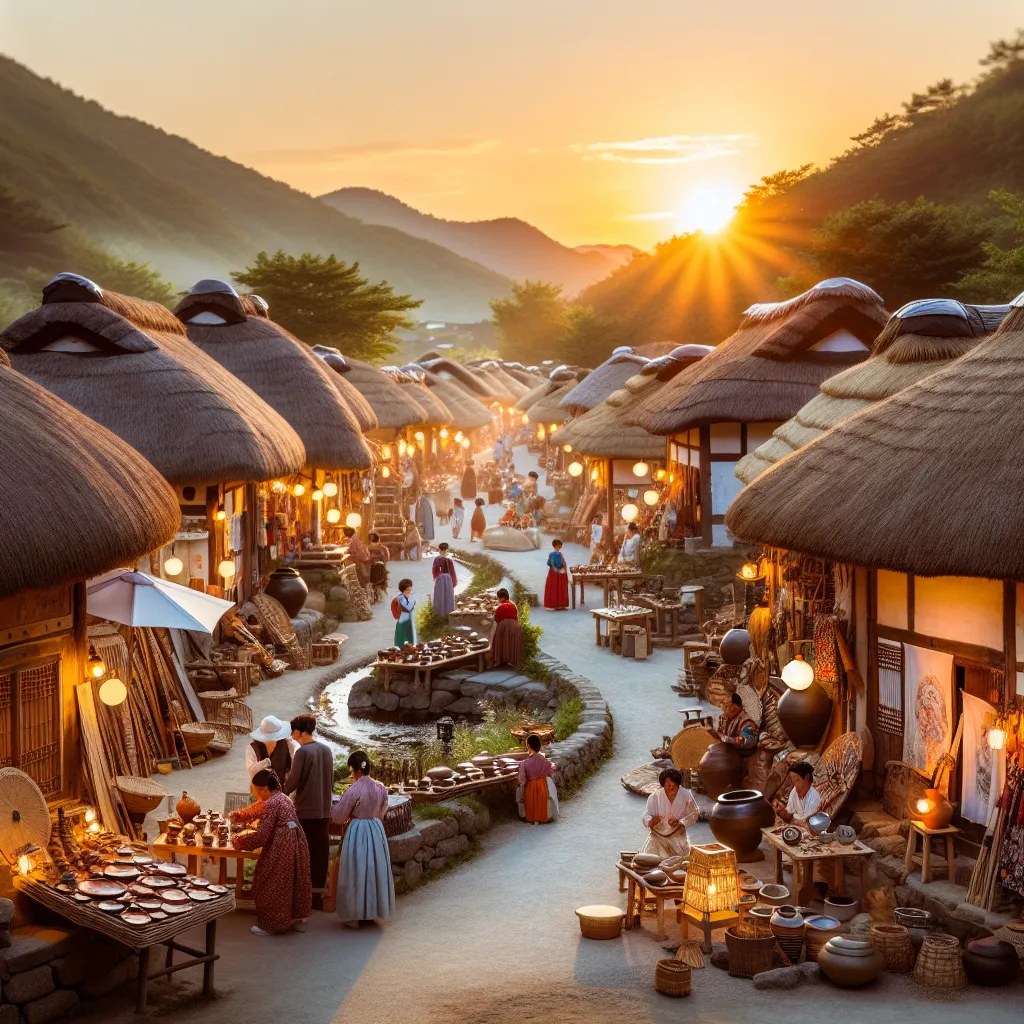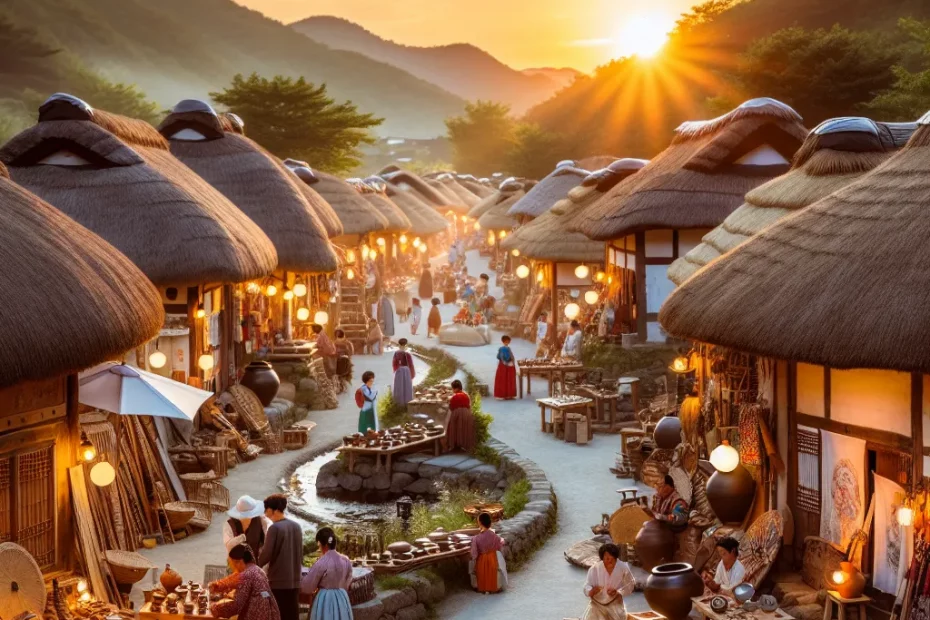Korean folk villages hold a special place in preserving the traditional ways of life and culture of Korea. These villages serve as living museums, showcasing the historical significance of the country’s heritage. The architecture and crafts found in these villages offer a glimpse into the past, highlighting the skills and traditions passed down through generations. However, despite their importance, Korean folk villages face challenges in preserving their authenticity in the modern world. By understanding the value of these cultural treasures, we can ensure that future generations continue to appreciate and learn from the legacy of Korean folk villages.

Introduction to Korean Folk Villages
Preserving Heritage
Korean Folk Villages play a crucial role in preserving the intangible cultural heritage of Korea. Through meticulous attention to detail, these villages recreate the atmosphere of bygone eras, allowing visitors to immerse themselves in the sights, sounds, and smells of traditional Korean life.
Traditional Architecture
One of the most striking features of Korean Folk Villages is the traditional architecture on display. Hanok houses, with their curved tiled roofs and wooden beams, offer a window into the architectural styles of ancient Korea. The layout of these houses, designed to harmonize with nature, reflects the deep connection Koreans have with the land.
Cultural Performances
In addition to static displays, Korean Folk Villages often host cultural performances that showcase traditional music, dance, and rituals. These performances breathe life into the historical artifacts, allowing visitors to experience the vibrant traditions of Korea firsthand.
Culinary Delights
No visit to a Korean Folk Village would be complete without sampling the traditional cuisine. From savory kimchi to hearty bibimbap, these villages offer a taste of authentic Korean dishes prepared according to age-old recipes.
Craftsmanship
Artisans in Korean Folk Villages practice traditional crafts such as pottery, weaving, and papermaking, keeping alive skills that have been passed down through generations. Visitors can observe these craftsmen at work, gaining insight into the meticulous techniques behind each handmade piece.
Natural Beauty
Nestled amidst lush greenery and rolling hills, Korean Folk Villages provide a tranquil escape from the hustle and bustle of modern life. The serene surroundings enhance the immersive experience, transporting visitors to a simpler time.
By preserving traditional ways of life and celebrating Korea’s cultural heritage, Korean Folk Villages serve as invaluable repositories of history and tradition. Through their dedication to authenticity and attention to detail, these villages ensure that the legacy of Korea’s past will continue to thrive for generations to come. 🌟
Historical Significance of Korean Folk Villages
In the realm of cultural heritage, Korean folk villages stand as pillars of tradition, preserving the essence of a bygone era. These living museums offer a glimpse into the past, showcasing the rich tapestry of Korean history and the enduring legacy of its people. With over 260 traditional villages scattered across the Korean peninsula, each village tells a unique story, steeped in centuries-old customs and practices.
Preserving Architectural Marvels
One of the most striking features of Korean folk villages is their traditional architecture. Hanok houses, with their curved tiled roofs and wooden beams, reflect the ingenuity of Korean craftsmen. These structures, meticulously preserved in folk villages, serve as a testament to the architectural prowess of ancient Korea.
Cultural Heritage Conservation
Beyond their architectural beauty, Korean folk villages are repositories of intangible cultural heritage. From traditional clothing like the hanbok to age-old rituals and ceremonies, these villages keep alive the customs and traditions that define Korean identity. Visitors to these villages can partake in traditional activities, such as tea ceremonies and folk performances, immersing themselves in Korea’s rich cultural tapestry.
Agricultural Traditions
Korean folk villages also offer insights into the agricultural practices of yesteryears. With rice paddies, thatched-roof houses, and traditional farming tools, these villages paint a vivid picture of rural life in ancient Korea. The agricultural techniques passed down through generations showcase the resourcefulness and resilience of Korean farmers.
Living History
What sets Korean folk villages apart is their immersive nature. Visitors can interact with villagers dressed in traditional attire, engage in age-old crafts like pottery and weaving, and savor authentic Korean cuisine. This hands-on experience breathes life into history, allowing visitors to forge a personal connection with Korea’s cultural heritage.
Preservation Efforts
The significance of Korean folk villages extends beyond mere preservation. These living museums play a crucial role in safeguarding Korea’s cultural legacy for future generations. By promoting awareness and appreciation of traditional ways of life, folk villages ensure that Korea’s heritage remains vibrant and relevant in the modern world.
In conclusion, Korean folk villages serve as invaluable repositories of Korea’s cultural heritage, offering a window into the past and a bridge to the future. Through their preservation of traditional architecture, customs, and practices, these villages stand as testaments to the enduring spirit of the Korean people. Visiting a Korean folk village is not just a journey through time; it is a celebration of Korea’s rich and diverse cultural legacy.
Traditional Architecture and Crafts
In the realm of Korean folk villages, traditional architecture and crafts stand as testaments to the rich cultural heritage and craftsmanship of the past. These villages, meticulously preserved to maintain their authenticity, offer a glimpse into a bygone era where architectural marvels and intricate crafts flourished.
Architectural Splendor:
The traditional Korean hanok houses, characterized by their curved tiled roofs and wooden structures, showcase the ingenuity of ancient Korean architects. The layout of these houses, with their ondol heating system and paper sliding doors, reflects a deep understanding of nature and harmony.
Craftsmanship Excellence:
Within these villages, skilled artisans practice time-honored crafts such as pottery, weaving, and woodworking. The delicate art of making traditional Korean ceramics, known for their elegant designs and vibrant colors, continues to thrive in these cultural enclaves.
Preserving Heritage:
The meticulous preservation of traditional architecture and crafts in Korean folk villages is not merely a nod to the past but a commitment to safeguarding cultural identity for future generations. By maintaining these living museums, Korea ensures that the legacy of its ancestors remains alive and vibrant.
Artistic Expression:
The intricate patterns adorning traditional Korean crafts, from embroidered textiles to lacquerware, speak volumes about the artistic sensibilities of the past. Each piece tells a story of dedication, skill, and a deep connection to the land.
Harmony with Nature:
Traditional Korean architecture and crafts are not just about aesthetics; they embody a philosophy of living in harmony with nature. The use of natural materials and sustainable practices in construction and craftsmanship reflects a deep respect for the environment.
In conclusion, the legacy of Korean folk villages is a testament to the enduring beauty and significance of traditional architecture and crafts. By preserving these cultural treasures, Korea honors its past and paves the way for a future where heritage and innovation coexist in perfect harmony.
Challenges in Preserving Korean Folk Villages
Preserving Korean folk villages poses a multitude of challenges that require careful consideration and strategic planning. One of the primary obstacles is the rapid urbanization and modernization of South Korea, which has led to the neglect and deterioration of traditional rural areas. As of 2021, only 1.3% of South Korea’s population resides in rural areas, highlighting the dwindling interest in traditional ways of life. This shift in demographics has made it increasingly difficult to find individuals willing to continue the legacy of Korean folk villages.
The Impact of Urbanization
Furthermore, the lack of financial resources allocated to the preservation and maintenance of these villages has hindered efforts to safeguard their cultural heritage. In 2020, the Korean government allocated only 0.1% of its total budget to cultural heritage preservation, indicating a lack of prioritization in this area. Without adequate funding, it becomes challenging to implement conservation projects, conduct necessary repairs, and provide educational programs to raise awareness about the importance of Korean folk villages.
Natural Disaster Threats
Another significant challenge is the threat of natural disasters, such as typhoons and earthquakes, which can cause irreparable damage to the traditional structures in these villages. With climate change leading to more frequent and severe weather events, the risk to Korean folk villages is only expected to increase in the coming years. Implementing disaster preparedness plans and ensuring the structural integrity of heritage buildings are crucial steps in mitigating this risk.
Loss of Traditional Skills
Additionally, the lack of skilled craftsmen and artisans who possess the knowledge and expertise to maintain traditional building techniques is a pressing issue. The transmission of these specialized skills from one generation to the next has been disrupted, leading to a shortage of individuals capable of preserving and restoring historical structures in Korean folk villages. Efforts to train a new generation of craftsmen and artisans must be prioritized to ensure the continuity of traditional craftsmanship.
In conclusion, the challenges in preserving Korean folk villages are multifaceted and require a concerted effort from government agencies, local communities, and heritage conservation organizations. By addressing issues such as urbanization, funding, natural disasters, and skills training, we can work towards safeguarding the rich cultural heritage embodied in these traditional villages. Only through collaborative action and sustainable practices can we ensure that future generations have the opportunity to experience and appreciate the unique legacy of Korean folk villages. 🏘️🌾🛠️
Korean folk villages play a crucial role in preserving the traditional ways of life and cultural heritage of Korea. These villages provide a glimpse into the past, showcasing historical architecture, crafts, and daily routines. By visiting these villages, people can immerse themselves in the rich history and traditions of Korea, gaining a deeper appreciation for the country’s cultural legacy. However, despite their significance, Korean folk villages face challenges in maintaining authenticity and attracting visitors in the modern era. It is essential to support efforts to preserve these valuable sites to ensure that future generations can continue to learn from and be inspired by Korea’s cultural heritage. Ultimately, Korean folk villages serve as living museums that connect the past with the present, offering a unique and educational experience for all who visit them.
